Many people dread peeling tomatoes. Faced with having to do it to any sizable quantity of tomato at all, their legs quake with terror.
It’s actually really easy.
You let hot water do all the work for you.
Why peel tomatoes?
Just about all home-canning recipes from reputable sources will call for tomatoes to be peeled before using in just about all recipes.
But why? Isn’t there a great deal of nutrition in tomato skins, and besides, it’s not as though there isn’t already enough prep work in canning…
- One reason is preference and habit: old-time cooks don’t like to get or see bits of paper-like peel in their food;
- The second reason is food safety to reduce the bacterial load by removing the skin, where a lot of bacteria will be.
Because the recipes are counting on that skin being removed, and the surface-layer bacteria and moulds with it, you need to bite the bullet and do it, even if you normally would ignore those directions for other non-canning recipes.
The USDA Complete Guide to Home Canning says,
Most bacteria, yeasts, and molds are difficult to remove from food surfaces. Washing fresh food reduces their numbers only slightly. Peeling root crops, underground stem crops, and tomatoes reduces their numbers greatly.” [1] United States Department of Agriculture (USDA). Complete guide to home canning. Agriculture information bulletin No. 539. 2015. Page 1-6.
The National Center for Home Food Preservation says,
Peeling tomatoes may seem like an unimportant extra step, but the texture of the skin was determined to be undesirable and product testing did not include considerations of how the skin would alter the final product safety. So, scald, peel, and chop tomatoes as described in the procedure. Our canning recommendations are meant to be followed as written, since that is how they were developed and changing ingredients or steps may influence not only the quality but also the safety of the final product.” [2]National Center for Home Food Preservation. Preserving Food at Home Blog. Try It: Tomato Jam. 19 August 2015.
See also: Why you have to peel some vegetables for home canning
How to peel tomatoes
Boil the tomatoes for 1 to 3 to 5 minutes (depending on the tomatoes) in hot water, then plunge them into a pan, sink or large bowl of very cold water.
The skins will pull off easily.
If they don’t, pop them back in the pot for a few more minutes boiling. The skin of some tomato varieties will cling more determinedly to the tomatoes than others.
But in the end, the skin does come off really easily.
(And remember, not only must jars of tomato products always be processed, they must also always be presumed to be low-acid products and have some acidity added to them to nudge them into the safe range.)
Tomato peeling machines
Some people hate the chore so much, regardless of the boiling water trick, that they invest in machines which skin the tomatoes for you.
This can be worthwhile if you know you will be canning tomatoes for years to come.
If you look for one, try searching on “tomato milling machine“.
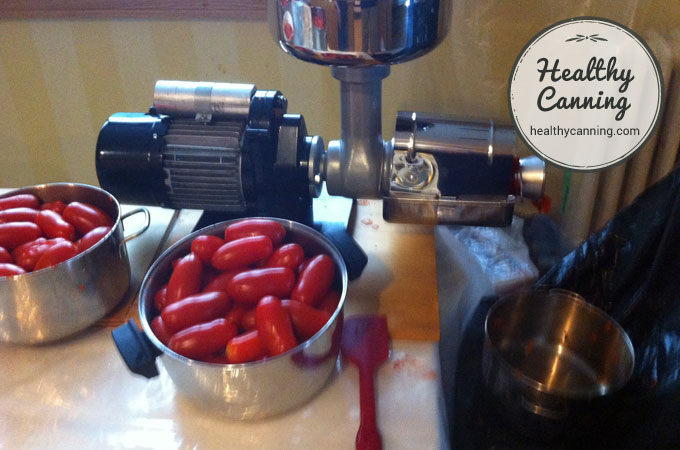
Tomato Milling Machine, possibly by Fabio Leonardi.
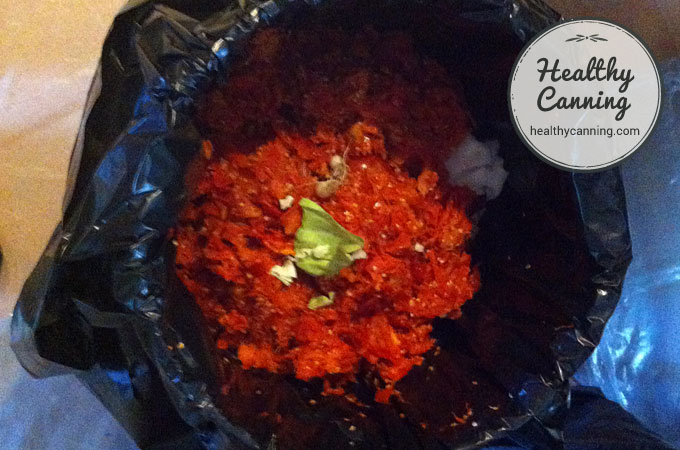
The discarded tomato skins
Tip for tomato skins
If you have any amount of tomato skins to speak of, you can make a tomato peel powder which you can use to jazz up salads, pastas or devilled eggs. Lightly oil a sheet of waxed (or parchment paper), place it on a baking sheet, distribute the tomato skins on it and bake for about 45 minutes at 110 C ( 225 F). Pulverize the dried skins in a blender, coffee or spice mill, etc, till they are a fine powder, and store refrigerated in a sealed container for up to a month, or freeze for up to 6 months. Courtesy: CooksInfo.
Further reading
More information about canning tomatoes in general.
Browse site on all tomato canning topics
References

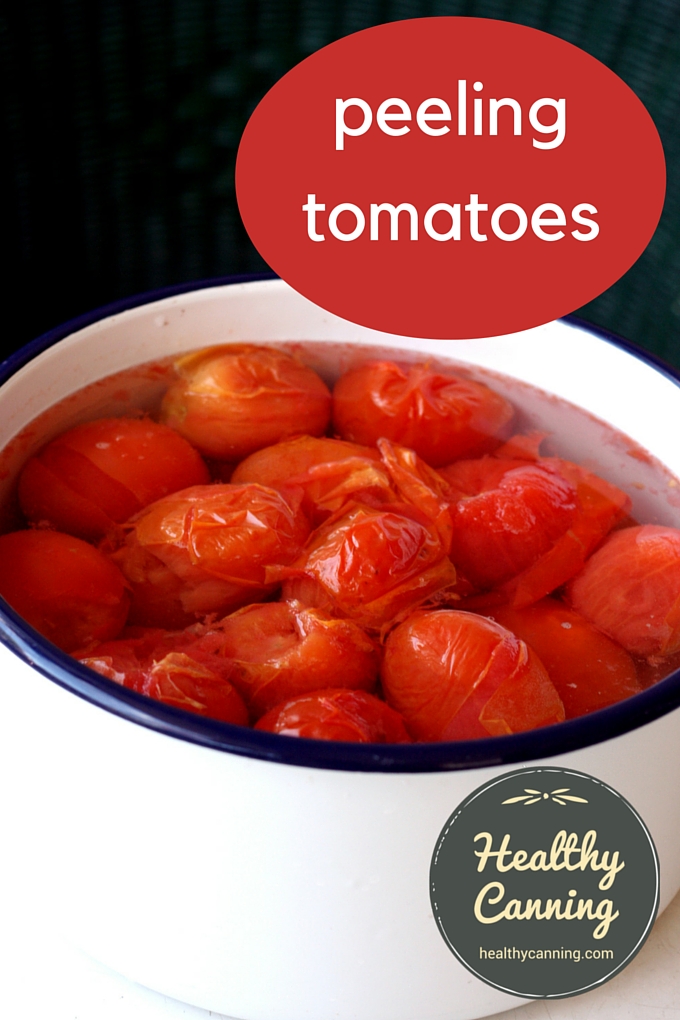
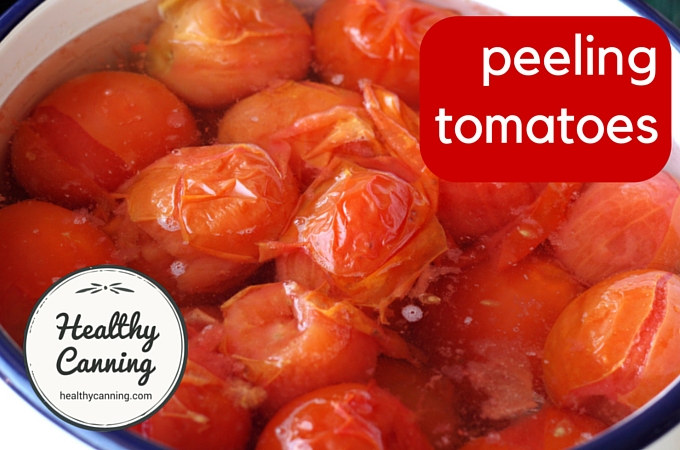
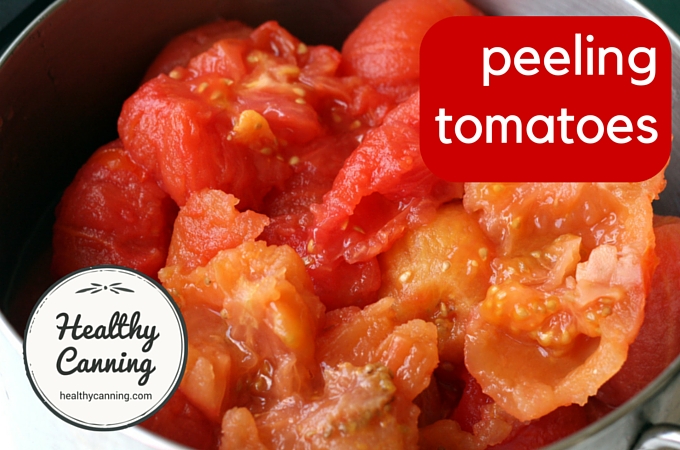
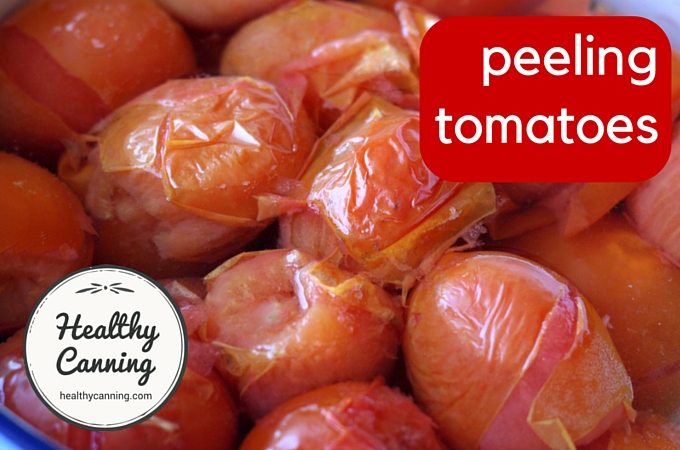
Kim
I’ve been reading all these articles about skins off, bacterial load etc., and somewhere in one of these articles from Healthy Canning it stated that adding acid is a must and gave directions for adding lemon juice. I am about to make your spaghetti sauce with meat recipe and there is no added lemon juice in it. Why not? And I peeled approximately 40 pounds of tomatoes, but had one small bag of San Marzano‘s that had been washed and frozen. I did not peel them and threw them into the cooker with the rest and now of course I’m freaking out a little bit …..but I’m more concerned about why I am not adding lemon juice.
Mohamed mousa
Very valuable information Dream of doing this project in Egypt
But I want to know what types of tomatoes are easy to peel and firm after peeling.
Judi
Does peeling the skin apply to both red ripe tomatoes and unripe green tomatoes? I just made salsa verde with very green cherry tomatoes using the Ball recipe but did not peel the green tomatoes. I tested the boiling water method to remove the skins but the skins were not coming off easily so I skipped the peeling.
Healthy Canning
Modern, research-tested recipes will tell you when you need to peel or not. Follow the guidance in those recipes.
Xochitl Gonzalez
I’ve had an amazing tomato year and for the first time, decided I should try to can my tomato sauce. I was happy to follow any recipe that kept the skin on the tomatoes and the seeds and core. But absolutely every recipe I could find had you either skin the tomatoes or core them. That just seems such a waste. The recipes all called for a certain amount of lemon juice to be added per jar. My question is can you leave the skins and not core or deseed the tomatoes and just add the appropriate amount of lemon juice per jar?
Also, is there a way that someone can create a recipe and then send it to a lab to be tested? I’d be happy to pay for the costs of the lab testing, since right now I’m freezing my sauce which is taking up quite a bit of freezer room.
Healthy Canning
For the issue of peeling, see above.
Don’t throw out tomato peels, they make amazing tomato powder: https://www.healthycanning.com/tomato-powder/
Catherine Hinkle
So a tomato peeling macine is OK? You put the washed tomatoes through, and it squishes the whole tomato together and strains out the peel. Do the bacteria get mixed wth the tomato pulp when this occurs? If not, why not? I have a friend who puts the whole tomatoes in a blender and does not remove the skin. Is this safe?
Healthy Canning
That is a good question, and many ask the same thing. The reason they ask is because the recipe developers actually had a very good reason for giving the directions the way they did, but didn’t explain why. The reason is to prevent unsightly separation of tomato solids and water in the jars after canning. The process the recipe writers gives deactivates the enzyme that causes this separation. See here: https://www.healthycanning.com/tomatoes-separating-jars/
Linda D
I’d love to know as well, thank you for asking!
Darlene Reynolds
Thank you! That’s the way I do it. But to me it’s not that much trouble.
I do need to get rude of the seeds. But I don’t. Thanks for feed back.
Misty Muse
I just put tomatoes in the freezer overnight, next morning take 5 or 6 out, hold under running water (cool or warm) and the peels slip right off. Then cut them open with a serrated knife, remove cores, and put into large kettle while I remove peels from the rest. Super easy and doesn’t require dealing with heavy steamy pot of boiling water, and fishing out slimy tomatoes with a slotted spoon!
Anita
Misty Muse, how long can you keep the tomatoes in the freezer? I have about a half batch that I picked today, with more coming on this next week. I don’t want to have them go bad, but I also really love the idea of the easy peeling.
Thanks for your help.
Tessa E Reeve
I have a couple questions on this tread. OK, I went to the website above and read the whole thing. In the process of peeling the tomatoes does the skin not come into contact with the meat of the tomatoes? Does this not cause the ‘bad’ stuff on the skins to contaminate the meat of the tomatoes? I know I sound picky, but I truly do not understand the reasoning. Boiling the tomatoes causes the meat to come into contact with the same water that is boiling the skins off. The other question I have is regarding the very next portion of the website where it is discussed using those VERY SAME SKINS to make a dehydrated tomato powder to then use for flavoring other foods. Where is the sense in that? If they are bad for one application, shouldn’t they be bad for another? It makes no logical sense to me. In the article you even stated as quoted from the National Center for Home Food Preservation, “product testing did not include considerations of how the skin would alter the final product safety”. Please help me understand, as I am not one to blindly follow a method just because a government agency/authority figure tells me it is so. I want proof. Not just a statement that someone says ‘well, we have always done it this way’ and ‘we didn’t test that scenario, so it must be bad’. Don’t get me wrong, I follow safe canning procedures, when they make sense and are logical. This is not logical. Sorry this is so long.
Healthy Canning
You have come to the right place to understand the why’s and wherefore’s. BTW, sometimes government authorities do actually know some stuff; they can be our relatives, our friends, our neighbours who actually know something and trained hard in their fields working in those jobs, and who care a lot about public safety, and not just because they are paid to. When it’s a problem is when they are paid and *don’t care.* But I digress.
The “bad stuff” is mainly in the very skin. By removing the skin you are reducing the bacterial load. Not eliminating it, but reducing it, enough for the tested canning process for that particular home-canned product to take care of. This is a very important tool of the trade, more info here: Reducing Bacterial Load. You also use this tool when you wash lettuce for a fresh salad at dinner. You won’t get every last speck of listeria or salmonella off the lettuce, but you are reducing it enough so that your body’s natural defences can deal with it and won’t be overwhelmed.
The bad stuff we are mostly concerned about here is botulism spores. They germinate in a moist, oxygen-free, low-acid environment. They won’t get any of that in a storage jar or container of tomato powder.
JUDY F.
Thank you for an answer to this question . I had the same question . It did not make sense to me how you could use the skins for powder but not in the stewed tomatoes. But you answered it.